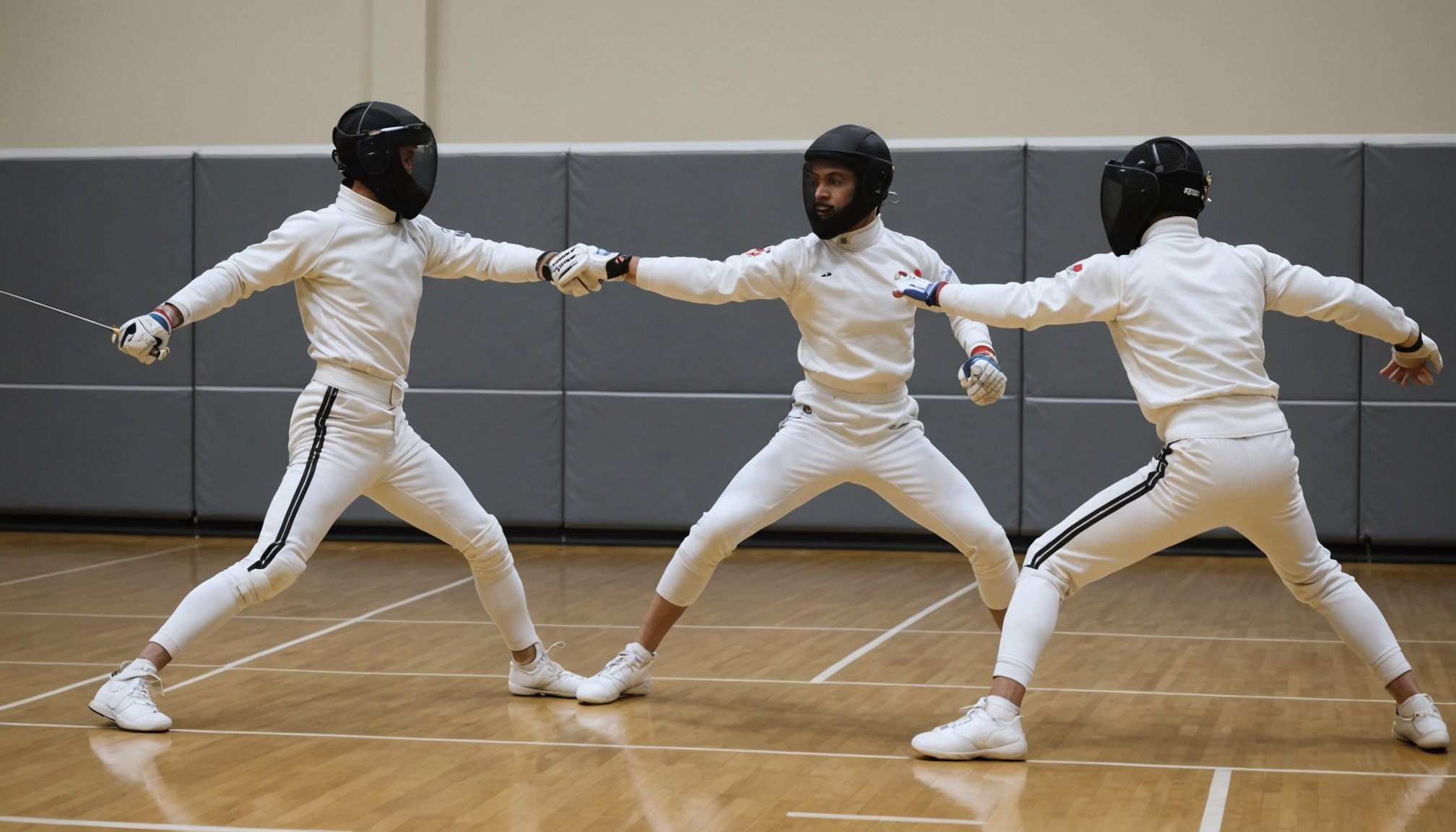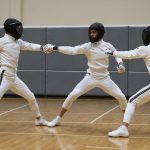Importance of Footwork in Fencing
Footwork in fencing is paramount to a fencer’s performance, providing a foundation for success in this intricate sport. Precise footwork improves a fencer’s agility, balance, and ability to swiftly manoeuvre while maintaining offense and defense positions. In fencing, elite athletes frequently highlight footwork as a critical skill; it enables effective engagement with opponents and the efficient execution of strategies.
Agility training plays a significant role in refining fencing performance. This type of training enhances a fencer’s ability to adapt to changing situations, react to an opponent’s attacks, and exploit openings. It isn’t solely about speed; it’s about the control and precision in movements, allowing fencers to both evade attacks and position themselves for effective counterattacks.
Also to discover : Unlocking cornering excellence: essential techniques for motocross riders to elevate race performance
Examples abound within the elite fencing community where footwork techniques are prioritised. Many successful fencers dedicate large portions of their training sessions to drills designed specifically to hone their footwork skills. These techniques are not confined to a single style but are a composite of various methods tailored to a fencer’s unique style and strategy. Such emphasis on footwork fundamentals underscores its undeniable importance in achieving competitive excellence in fencing.
Key Techniques for Improving Fencing Footwork
Fencing, a sport that thrives on precise movement, benefits immensely from structured footwork techniques. These techniques enhance both the defensive and offensive capabilities of athletes.
This might interest you : Unlocking Precision: Essential Mental Drills for Biathletes to Enhance Shooting Accuracy
Basic Footwork Drills
For novices, fundamental drills form the base of efficient footwork. These include exercises like the advance-retreat drill, where simple steps forward and back are practiced, allowing fencers to maintain proper form and control. Regular practice of these basics ensures the foundation is solid before progressing.
Advanced Movement Techniques
Once basic skills are in place, it’s crucial to learn advanced techniques like the lunge and fleche. These focus on quick changes in direction and speed, requiring a combination of strength and agility. Emphasizing elements such as the timing and fluidity of movements elevates a fencer’s tactical play.
Incorporating Agility Exercises
Integrating specific agility exercises accelerates improvements in footwork. Activities like ladder drills and cone exercises simulate competitive scenarios where swift, precise actions are necessary. Incorporating these into regular training aids in refining both explosive speed and responsive agility, crucial for effective fencing performance.
Drills to Boost Speed and Agility
In fencing, speed drills are instrumental in elevating a fencer’s agility and performance. Effective exercises often mirror actual competitive situations where quick reflexes are crucial. Incorporating drills such as shadow fencing places an emphasis on speed without an opponent, enabling fencers to focus on precision and technique.
Agility drills further translate training into tactical advantages. Incorporating scenarios such as mimic attacks against imaginary foes helps simulate pressures faced during bouts. Specific agility drills, like cone and ladder drills, are highly regarded for developing multifaceted movement proficiency. They challenge coordination and the ability to change direction swiftly, vital in outmaneuvering an opponent.
The frequency and duration of practice sessions are crucial. To maximise improvements, fencers should engage in speed and agility training three to four times a week. Each session should be at least 30 minutes, focusing on intensity to foster genuine enhancement. With sustained practices, these drills reinforce muscle memory and reflexes integral to advancing a fencer’s skill set.
Form and Balance Tips for Better Footwork
In fencing, balance techniques are integral to executing effective maneuvers. A strong base not only enhances combat readiness but also maximises a fencer’s tactical options.
Proper Stance and Positioning
Maintaining correct fencing form starts with a low, stable stance. Proper foot positioning ensures weight is evenly distributed, allowing swift transitions between offensive and defensive actions. This equilibrium is crucial in maintaining a fencer’s balance while pivoting and executing moves.
Balancing Exercises for Fencers
Incorporating balancing exercises can dramatically improve a fencer’s control. Activities such as single-leg stands or using stability equipment help build core strength and enhance overall fencing performance. These exercises improve stability, which is essential for maintaining composure during intense bouts.
Common Posture Mistakes
Avoiding errors in footwork is pivotal. Common mistakes include leaning too far forward or backward, which compromises balance and reaction time. Addressing these missteps allows fencers to maintain a centred position. Correcting posture not only refines footwork techniques but also sustains agility when under pressure. Through consistent refinement, fencers can ensure their style remains efficient and adaptable.
Visual Learning Methods for Footwork Techniques
Implementing visual aids significantly enhances learning for those focused on refining footwork in fencing. Video tutorials offer diverse perspectives and detailed demonstrations, aiding visual learners in grasping complex techniques more effectively. These resources break down movements step-by-step, ensuring clarity in execution.
Recommended platforms like YouTube feature expert fencers and trainers explaining essential fencing techniques. Channels such as “Fencing Hub” present a wealth of training resources, ranging from basic drills to advanced movements, catering to both novices and experienced athletes.
Moreover, recording and reviewing one’s own practice sessions is invaluable. Athletes can identify areas for improvement by observing their footwork, making necessary adjustments to enhance their fencing performance. This self-review process not only consolidates learning but also builds self-awareness in maintaining proper form and agility.
Benefits of Video Tutorials:
- Detailed analysis of each move
- Insight from seasoned professionals
- Ability to replay sections for better understanding
Utilising these methods equips fencers with comprehensive tools to advance their skills, fostering a more personalised approach to agility training and overall improvement.
Personal Insights from Coaches and Experienced Fencers
Gaining insights from experienced fencers offers invaluable lessons for mastering footwork in fencing. These insights provide practical knowledge that can elevate a fencer’s capacity for dynamic movement.
Analyzing Successful Fencers’ Techniques
Top fencers understand that mastering nuanced footwork techniques can drastically increase fencing performance. By studying their movements, aspiring athletes can decipher how established professionals adeptly balance agility training with tactical execution. Observing their transitions between offense and defense helps to reveal how subtle shifts in stance and speed provide an edge in competitions.
Coaching Tips for Aspiring Fencers
Coaching advice plays a pivotal role for beginners eager to enhance their skills. Coaches often emphasize not only the importance of regular practice but also adopting varied fencing drills to keep training engaging and effective. Structuring workouts with set goals ensures a structured progression in mastering various speed enhancement exercises.
Real-life Application of Footwork Techniques
Real-life testimonies from the fencing community underscore the transformative impact of proper footwork on performance. Fencers who’ve successfully incorporated precise techniques consistently outperform in bouts, demonstrating how crucial nuanced footwork can be in high-stress situations. Their narratives serve as motivational beacons, highlighting practical solutions for aspiring competitors.











